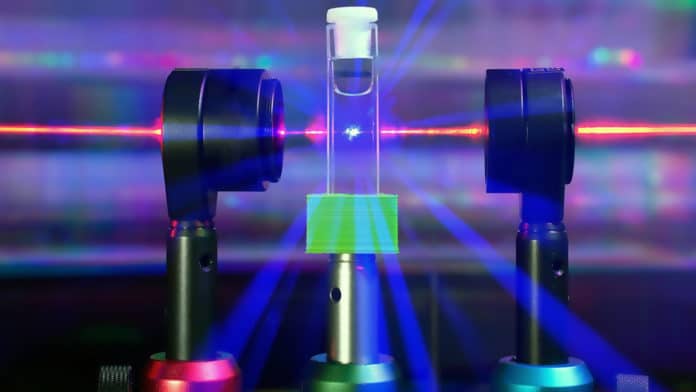Shining light with certain color (frequency) can produce harmonics (light frequencies 2fc, 3fc, 4fc, 5fc, 6fc, etc.). The harmonics of light reveal intricate material properties that find applications in medical imaging, communications, and laser technology.
Sometimes, the odd harmonics of light cannot propagate along the direction of light travel, and the corresponding colors are forbidden.
Now, physics researchers at the University of Bath in the UK have found a way to reveal the forbidden colors. They have discovered a new physical effect relating to the interactions between light and twisted materials. This effect could be used in emerging new nanotechnologies in communications, nanorobotics, and ultra-thin optical components.
Researchers achieved their results by curving their experimental equipment.
Professor Ventsislav Valev, who led the research, said: “The idea that the twist of nanoparticles or molecules could be revealed through even harmonics of light was first formulated over 42 years ago, by a young Ph.D. student—David Andrews. David thought his theory was too elusive ever to be validated experimentally, but we demonstrated this phenomenon two years ago. Now, we discovered that the twist of nanoparticles could be observed in the odd harmonics of light. It’s especially gratifying that the relevant theory was provided by none other than our co-author and nowadays well-established professor—David Andrews!”
“To take a musical analogy, until now, scientists who study twisted molecules (DNA, amino acids, proteins, sugars, etc.) and nanoparticles in water—the element of life—have illuminated them at a given frequency and have either observed that same frequency or its noise (inharmonic partial overtones). Our study opens up the study of the harmonic signatures of these twisted molecules. So, we can appreciate their ‘timbre’ for the first time.”
“From a practical point of view, our results offer a straightforward, user-friendly experimental method to achieve an unprecedented understanding of the interactions between light and twisted materials. Such interactions are at the heart of emerging new nanotechnologies in communications, nanorobotics, and ultra-thin optical components.”
“For instance, the ‘twist’ of nanoparticles can determine the value of information bits (for a left-handed or right-handed twist). It is also present in the propellers for nanorobots and can affect the direction of propagation for a laser beam. Moreover, our method is applicable in tiny volumes of illumination, suitable for the analysis of natural chemical products that are promising for new pharmaceuticals but where the available material is often scarce.”
Ph.D. student Lukas Ohnoutek, also involved in the research, said: “We came very close to missing this discovery. Our initial equipment was not ‘tuned’ well, so we kept seeing nothing at the third-harmonic. I was starting to lose hope, but we had a meeting, identified potential issues, and investigated them systematically until we discovered the problem. It is wonderful to experience the scientific method at work, especially when it leads to scientific discovery!”
Journal Reference:
- Lukas Ohnoutek et al., Optical Activity in Third‐Harmonic Rayleigh Scattering: A New Route for Measuring Chirality, Laser & Photonics Reviews (2021). DOI: 10.1002/lpor.202100235
